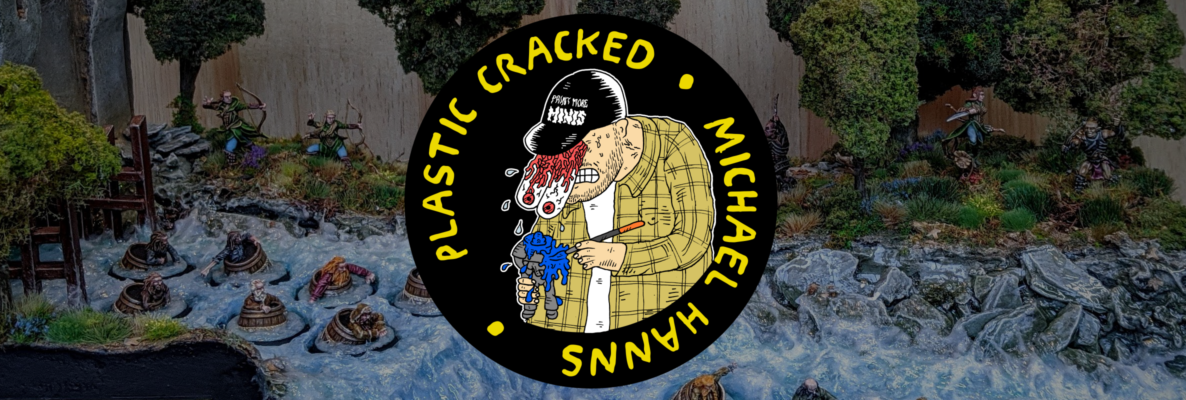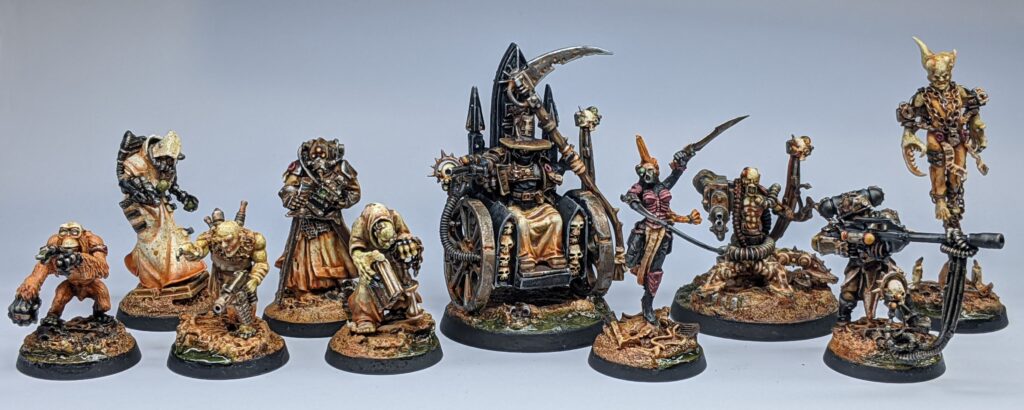
Update 13/01/2022: These models were in the Conversion Corner of the Readers Models section of White Dwarf issue 472 (January 2022)!
It’s been a bit of a turbulent time for my hobby as of late. After finally completing the Emperor Protects – the longest consecutively1 running series of posts on this blog to date – I haven’t quite figured out what I want to do with myself. I’ve bounced around from project to project – painting massive dragons, doing weird things with terrain, and even painting more Sororitas – but I can’t quite seem to settle on my next big project. It turns out there’s such a thing as too much choice and decision paralysis has me wavering back and forth between all sorts of wild notions, unable to commit to one for fear of missing out on the others. It’s a conundrum as old as miniature wargaming itself; sometimes you’ve just got to ride the waves of uncertainty until you fall ass first into the Next Big Thing.
You may remember that a couple of posts ago I mentioned I’ve been playing a lot of Demon’s Souls, Dark Souls and Bloodborne recently. I went as far as to try and capture the feel of Yarnham with my gothic ruins terrain, which had me tossing around a few ideas for a second Mordheim warband – the most enduring of which was the Witch Hunters warband. Not only an excellent foil for my Skaven but also sort of the poster boys for the Mordheim aesthetic, which makes them ideal for demonstration games. I also had a lot of fresh and nifty ideas coming from Bloodborne. I don’t often attempt to recreate characters from other fictional settings in my miniatures, but I do like to bring ideas and concepts over as influences on my own content. Weapons like saw cleavers would fit perfectly in with a Witch Hunters warband, but more than anything I kind of wanted my Witch Hunter Captain to evoke the character of Gehrman, the First Hunter.

The Old Hunter has a few distinguishing features – the tattered Witch Hunter-esque attiture (complete with top hat), the Burial Blade trick weapon and, of course, his Victorian-styled baroque wheelchair. I’d never made a miniature in a wheelchair before, and it just really seemed like it would be a fun challenge. To the best of my knowledge, there are no equivalent miniatures in the entire Games Workshop range, so it would be interesting to pair the right kind of seated legs with the right torso and either scratch build or convert the chair itself. I had it all planned out.
And then more Adepta Sororitas happened, leading me to paint up a squad of Arco-Flagellants – and found myself in need of an Inquisitor to lead them.
As much as I wanted to make this second warband for Mordheim happen, I couldn’t shake the idea that this wheelchair-bound Witch Hunter Captain character I was theorising could become something even more unique and characterful in 40K. I had this vision of an Ordo Hereticus Inquisitor in a manual wheelchair, flanked by Cherubs and/or Servo-Skulls to spin the wheels and balance the chair. There’s just something innately Warhammer 40,000 about this way of over-engineering a simple problem, employing menial robots to perform a manual function instead of adding a pair of stabilisers and a motor.
I spent some time scouring the internet for inspiration and suitable parts for my Inquisitor – the hardest part to source being a suitable pair of seated legs. I considered Knight pilots, Titan pilots, Sentinal pilots – a lot of pilots. In the end, I found the most suitable legs under my nose the whole time – with Inquisitor Karamazov. Can we just take a moment to appreciate what a cool 40K miniature Karamazov is? An imposing presence, seated on a walking Throne of Judgement styled after an Astartes Castraferrum Dreadnought, flanked by creepy looking servitors and packing a triple barrelled multi-melta. It’s just great. I’d initially written Karamazov off as the basis for the conversion, assuming his legs would cast with the throne as a single piece. Not the case, as it turns out – a Google image search provided me with a snapshot of the components, including a very useful pair of seated – and separate – legs. I bit the bullet and ordered the kit, telling myself it was okay to spend however much on a kit just for a pair of legs because the rest of the kit would be useful for future kitbashing. At the time, I had no idea how right I was about this.
When my order arrived and I saw the parts out in front of me, I realised the Throne of Judgement itself could make a perfect baroque looking wheelchair without an awful lot of work. The back of the throne needed a little filling to create a level chair, but otherwise it was pretty much good to go. I found a pair of wheels for an old Ork Artillery piece on eBay and set about attaching them, after filing them down on either side in an attempt to make them look a little less chunky.
For the torso of my Inquisitor himself, I used an ‘Inquisitor with Inferno Pistol and Power Sword‘, sawed him in half at the waist and stuck him onto Karamazov’s legs. Although I loved the design of his flintlock inferno pistol, his left hand seemed by far the best place for him to hold a meaty power scythe, so I cut away at it and replaced it with my own converted power scythe, made from a Blightking scythe with a power unit taken from a 40K Space Marine power axe. This left his other hand free, which of course demanded a firearm. My original plan here was to use an Adepta Sororitas Inferno Pistol, but I ended up replacing this after painting because it just seemed a little too plain. In the end, I scratch built him a custom weapon out of an Empire Pistolier blackpowder pistol, with a scope and side-loading ammo clip from a Sororitas bolter and a power cable from a Sororitas meltagun. I kind of have it in my head that it’s a custom modified Archeotech Pistol, but I’ll probably run it as a Needle Pistol in games of Warhammer 40,000.
The final touch was the servo-skulls. I stuck one into each of the wheel sprockets on either side, took out my ol’ reliable Green Stuff Roll Maker and made some extensions looping around the wheels with the intention of making it look like they’re the one’s moving it. Just uh… Try not to think too hard about the physics of what would happen to a servo skull intwined in the wheels like that. Anyway, while I had the roll maker out, I made some fatter looking cabling rolls and used them to create further tubing and cabling for the life support systems on the wheelchair – this also helped to fill out some of the flat contact areas left exposed (by not fully assembling the Throne of Judgement).FI t
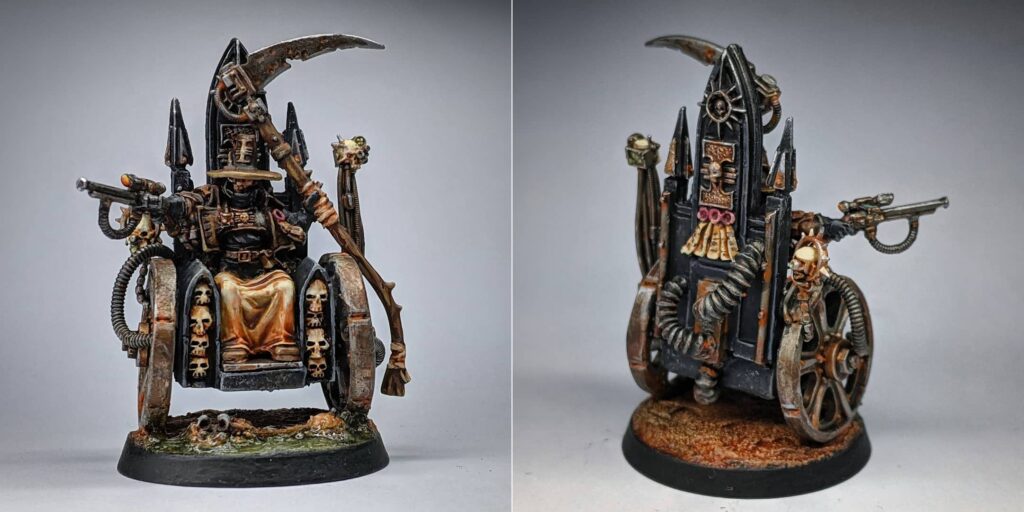
A native to the Hive World ++REDACTED++, notorious for its frequency of warp storms during which warp sensitive individuals are susceptible to high psychic instability. For this reason, the Ordo Hereticus has a constant presence in the system and every citizen is required to submit to regular testing and observation for warp sensitivity. Rogue psykers are considered highly dangerous, and so any susceptible citizens are taken off world – more often than not to fuel the light of the Astronomicon.
The middle child of a family of three, Sebastians parents had learned of their youngest daughters warp sensitivity and – using every trick in the book – kept this information from the Ordo Hereticus to preserve the life of their child. This failure in duty led to a catastrophic psychic outburst from the child, killing the Von Dernbach family in their entirety, save for Sebastian. Upon seeing his parents murdered, the child acted pragmatically and mercifully ended his younger siblings life in an effort to preserve his own and end her suffering. The experience left Sebastian paralysed from the waist down. Upon learning of Sebastians actions, Inquisitor Augustine Jaeger took the child under her wing and groomed him to become an Inquisitor in the Ordo Hereticus.
A self-confessed pessimist, Sebastian holds a grim view of the Imperium at large, which he believes will eventually succumb to the terrors of the warp due to the fallible nature of mankind and it’s ability to make the tough calls. In this regard, he believes that the work of the Ordo Hereticus is thus instrumental in the postponement on mankinds extinction. Von Dernbach has been known to work extensively with the similarly pessimistic Sororitas Ordo Minoris the Order of the Dying Light in prosecuting wars against the Imperium itself, although his radical approach to his Inquisitoral duties – employing sanctioned mutants, xenos and even Daemonhosts – has put him at odds with Canoness Superior Caliope Lucerna on more than one occasion.
After slapping him down on a 40mm base, my Inquisitor was finished and ready for a coat of paint. That was supposed to be the end of it, but I didn’t stop there. I couldn’t stop there. I was having way too much fun to stop there.
I didn’t really think that much about it at first. My bitz box was already out on the table, and I was feeling confident with how well my Inquisitor kitbash had turned out. Over the past few weeks, I’d been listening to the Eisenhorn trilogy on audiobook while painting my most recent Sororitas miniatures and I guess you could say I had found my muse. I took the Scribe Servitor from the Throne of Judgement and attached it to a spare set of legs from an Empire Flagellants kit. For hands, I used an oversized pair from a Plaguebearers plastic kit and precariously slipped a large tome and an hourglass attached to a chain into their grasp. I had made myself something that looked a bit like a Savant – like Uber Aemos from the Eisenhorn series.
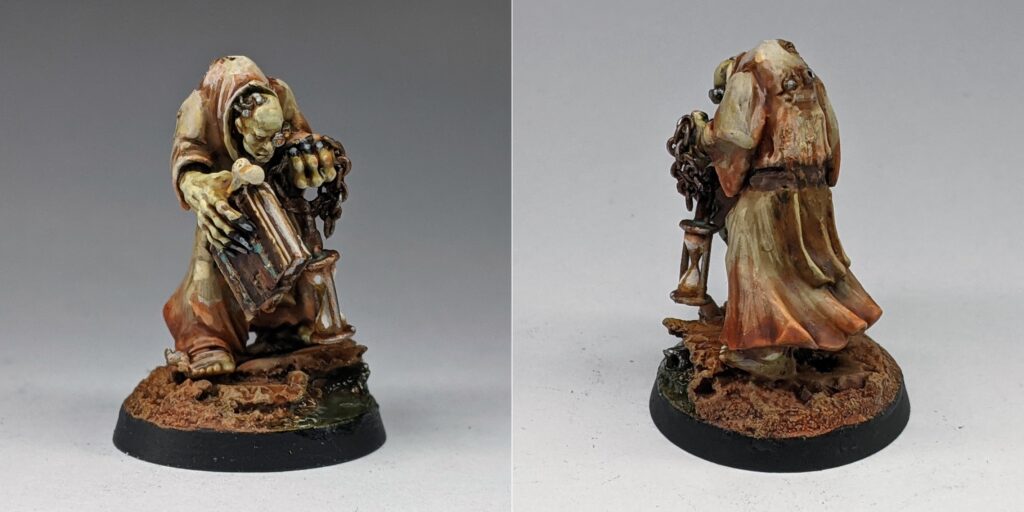
One of Von Dernbach’s oldest crew members, Savant Laurentius Salaman was assigned to the Inquisitor along with the ship the Embers of the Emperor.
Salaman originally hails from Imperial planet Harenae VI – where a genetic deviation causes human hands to continue growing with age, and large hands are considered a symbol of wisdom. Salaman has an eidetic memory, preferring to study from written tomes rather than data slates, making him exceptionally suited for his role as Savant. His manner is calm and collected – this is partially due to his obsession with time, which he is obsessed with counting, measured by his own rhymthic breathing, heart rate and a gravity-insulated hourglass which he keeps on his person at all times. Although most often simply a frustrating compulsion to those around him, his obsession with the passage of time allows Salaman to keep a level head during even extended periods of warp travel where others may feel disorientated. In his role as Savant, Salman has been both a confidant and voice of reason for Von Dernbach when the rigours and paranoias of witch hunting overwhelm the Inquisitor.
I kept on going. There was no mistaking the other Servitor from the Throne of Judgement for anything other than a lobotomised semi-organic menial, so I made that one into a Combat Servitor with a set of mechanical crab legs that I fashioned out of what I think are spare toes from an Imperial Knight kit. His weapon arms were made from an old pintle mounted Heavy Flamer and an Arco-Flagellants whip arm. I covered up the awkward joints and gave his body a little more heft with a series of interwinding tubes and cables that I made using a Roll Maker Set from Green Stuff World. As a final touch, I added a Servo Skull emerging from the various cabling and tubings – it just seemed like it fit – and thus the idea to call this Servitor ‘The Twins’ emerged.
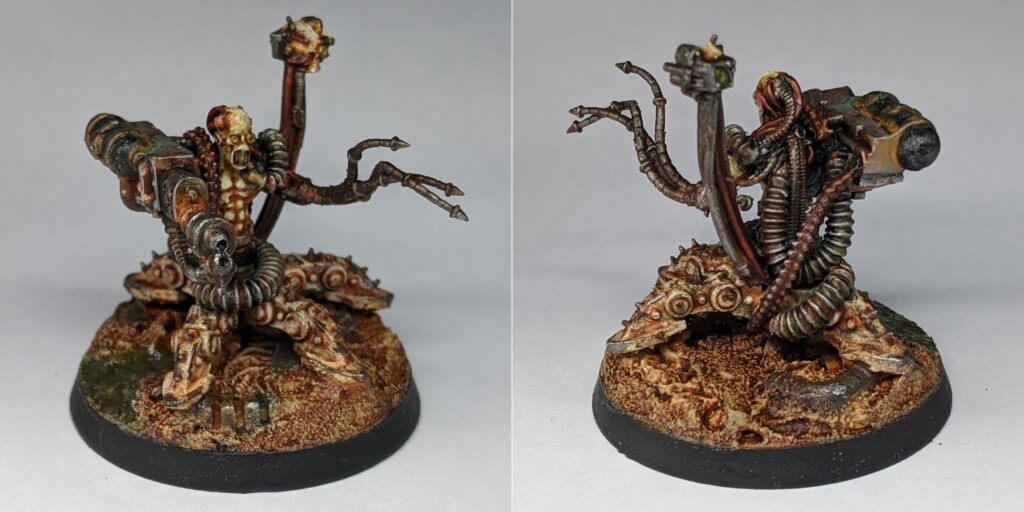
One of Jokaero Pygmaeus’ more unsettling creations. Combat Servitor RNG82-12 is the product of two critically damaged machine spirits – a Servo Skull and an embedded weapon targeting Servitor – installed into the same mobile weapons platform. Diagnostics have confirmed the resulting Servitor unit to be largely stable – a genius amalgam of two faulty machine spirits, each compensating for the damaged subroutines of the other. Despite this apparent harmony of function, RNG82-12 has been observed ‘bickering’ with itself on occasion due to the inherent differences of protocol in the two machine spirits programming. This internal dissent largely manifests itself through unintentional outbursts of binaric code, although occasionally devolves into sudden jerking movements as the machine spirits quarrel over control of their own shared limbs – earning Servitor RNG82-12 it’s nickname ‘The Twins’.
I went hunting through my bits box, looking for any odds and ends I might have had that fit the Blanchitsu tone that I was aiming for. Eventually, I stumbled upon a Comms torso from the old Renegades and Heretics ForgeWorld upgrade pack that I’d used way back when to make some Chaos Cultists. In my hunt for a suitable pair of legs, I stumbled on some hacked up Army of the Dead miniatures from my Black Numenorean conversions which seemed just the ticket. A little bit of creative cutting to remove the torso and the cloak from behind the legs and I had a grungy looking soldier with a rebreather, a third eye and a pretty stoic pose. To help sell the pose, I took the sword arm from Karamazov, and replaced the blade itself with a power sword from a Seraphim kit – that way I could match it to a spare scabbard I had from a Battle Sisters kit, which would help cover some of the rough cutting work I did on the legs. I decided that between the rebreather, comms equipment and stoic pose, this model was absolutely a pilot. I almost filed down the third eye on the helmet before it occurred to me exactly who this model was – an Imperial Navigator.
At this point, I sort of knew what I was doing. I was making an Inquisitorial retinue – not just an Inquisitor and a group of soldiers, but individuals with their own personalities and roles within the crew. I already had a Savant, a Servitor and a Navigator – now it was time to add some muscle.
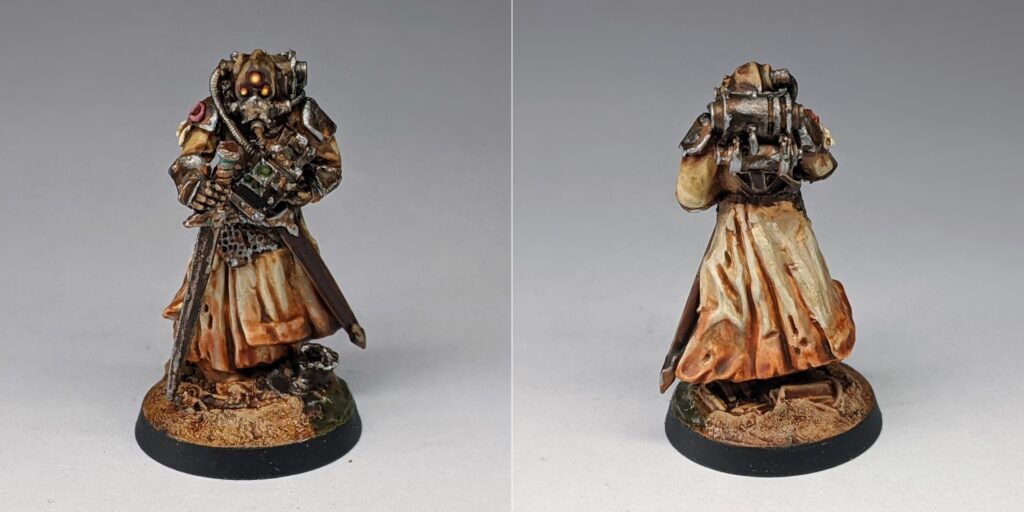
The product of a political marriage between esteemed Terran Navigator Family Molineux and Mars Knight Household Lautrec, Amadeus Molineaux is not simply an experienced Imperial Navigator but a potent psyker and skilled swordsman.
One of Von Dernbach’s longest serving crew members, Molineaux has adopted a quiet and stoic manner – perhaps as a self-defence mechanism, so as not to draw the ire of the zealous and judgemental Inquisitor that he serves.
The Navigator and Servitor were both armed with close proximity weapons – a power sword and heavy flamer respectively – so I wanted this guy to specialise in long range firefights. I went digging in my bitz box to find something to represent a Long Las until I eventually stumbled on an interesting looking Meltagun upgrade for Renegades and Heretics which seemed like a good basis for a sniper rifle. I filed the Chaos star from the shoulder and snipped the melta compensator from the end of the gun, replacing it with a long thin barrel which I fashioned from a polearm from the Flagellant kit. The pièce de résistance a muzzle for the sniper rifle, which I fashioned from the end of a Predator autocannon.
I wanted my Soldier character to look a little better armoured – something a bit sturdier than flak without going full Space Marine in powered armour. Once again here, Karamazov is the kit that just keeps giving, and I was able to source both a torso and a left arm from that kit. I was starting to struggle a bit with legs here – unfortunately, I’ve never (in my adult life) built any Imperial Guard miniatures, so I’m a little bit short on suitable spare ‘soldier’ legs. Were I planning this conversion a little more in advance, I might’ve purchased a box of Tempestus Scions or even some Empire Greatswords, but I decided to make do with what I had and used a pair of spare Wood Elf legs I had leftover from some conversion or another. I used my hobby knife to cut away at some of the leafier, triangular patterns on the boots that looked a bit too Peter Pan, and I think I just about got away with it. The stance looked right for a sniper, although – bad ass though he was – I didn’t really like how he was just freehanding a long las, so I combined another Servo-Skull with my trusty Roll Maker and made a little Tripod companion for my sharpshooter. For the head, I combined a Flagellant head with a visor carefully cut away from an Arco-Flagellant. This gave a bit of a grim dark Scout vibe to the model and inspired his backstory as an Imperial Deserter. Finally, I stuck a Sororitas power plant on his back – he might not be properly power-armoured, but I figure he’s got a fair whack of gear to power and – as his torso was designed to be seated – he seemed a bit like he could use the extra bulk.
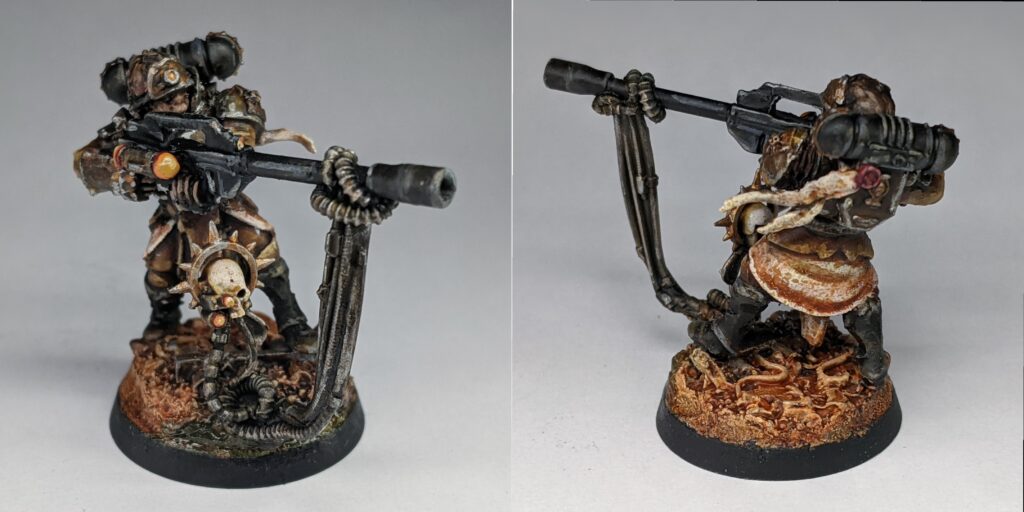
A former member of the prestigious Tempestus Scions, now an Imperial deserter following the turbulent events of ++REDACTED++, Sparta Libritor was MIA – presumed dead – for 30 Imperial years until discovered by Inquisitor Sebastian von Dernbach. A bounty hunter in the capital hive city of Candetem IV, Libritor was first contracted by the Inquisitor to help track down a dangerous rogue psyker believed to be taking refuge in the city. Following the success of the mission, a background check revealed the mercenary to be an Imperial Deserter, and the Inquisitor offered Libritor a chance at redemption as a servant of the God Emperor once again – a preferable alternative to summary execution for desertion.
Sparta Libritor now serves as muscle for the Inquisitor when necessary, as well as fulfilling the role of scout/sniper with his custom long las and Servo-Skull ‘Tripod’. In the field, Libritor wears a special visor fashioned in the image of an Arco-Flagellant neural implant, which serves as both a targeting interface to his long las and a grim reminder of the fate that awaits those who fail in their duties to the Inquisition.
So, we’ve got ourselves an Inquisitor, a Savant, a Servitor, Navigator and some muscle. The crew was starting to look fairly well rounded, so now I was free to start adding the weirdos – the first of which was the classic Daemonhost. After reading Eisenhorn trilogy, how could I not?
As Daemonhosts are often depicted as bound and restrained, I was starting from a very familiar place – a spare Penitent Engine pilot. The Penitents body provided the basic frame and much of the bondage, but it wasn’t looking all that daemonic yet. I had a look through my various daemon and Chaos bitz baggies and eventually stumbled upon one of the optional bodies for the Rogue Psykers in Blackstone Fortress. This provided with me with a big, ugly bulbous head mutation, as well as a neat little weighted chain used to give the Rogue Psyker the appearance that it’s levitating – ideal for my restrained Daemonhost. Next, I found a pair of hands from a couple of different daemon kits – one Plaguebearer hand and a Daemonette claw – to replace the human hands and bring a little more daemonic energy to the miniature.
To round it all off, I got a little hobby chain and wrapped it around the body of the miniature and down to the ankles – it’s not a perfect match to the plastic sculpted chains on the base, but it’s close enough after a coat of paint. A couple purity seals from a Battle Sisters kit, and the conversion was complete. One of the major differing factors between my Daemonhost and the old Games Workshop offering was that mine was wearing a kind of prisoners jump suit – I decided to lean into this. When it came time to paint the miniature, I painted the jump suit orange with the notion that the host would’ve been a prisoner of some sorts. This was a convenient decision for my colour scheme, really, but it’s also another great example of the conversion taking on a life of its own. I’m learning on this project that it’s surprisingly easy (and rather enjoyable) to come up with detailed backstories for miniatures given enough visual cues such as outlandish gear or unusual physical traits.
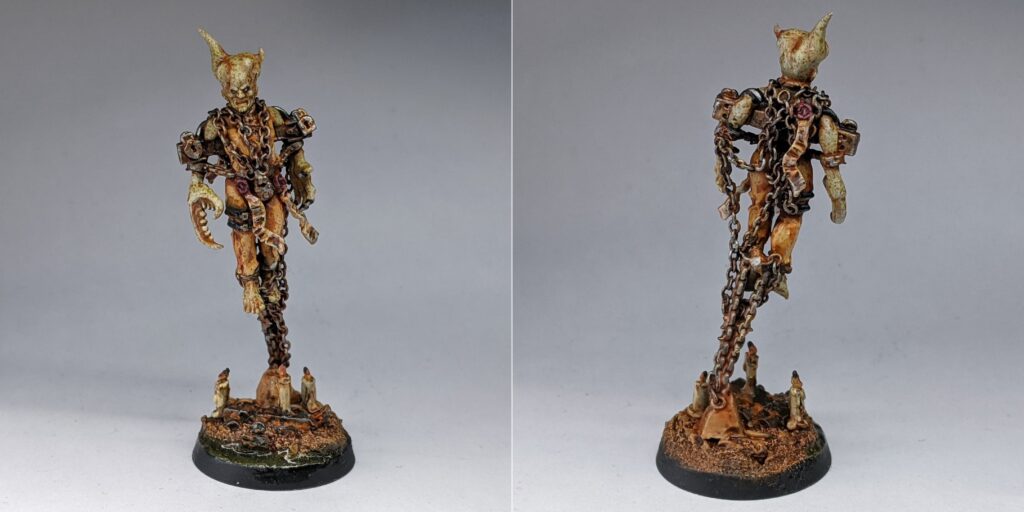
When Inquisitor Sebastian Von Dernbach shut down a vast underground network of Slaanesh cultists in the underhives of Gaius IV, he captured 143 prisoners with the intention of delivering them to the Ecclesiarchy for use as Arco-Flagellants. En route to Imperial space however, several Cultists had managed to conduct secretive Daemonology rituals in transit, culminating in the summoning of the daemon Kokabael.
While still incorporeal, the daemon managed to free several prisoners who in turn overwhelmed several crew or the Embers of the Emperor. The riot was eventually quelled by the Inquisitor and his team, although at great cost. Far more difficult to pacify however was Kokabael, who had infested and corrupted several of the prisoners, using their corporeal form to wreck havoc amongst the ship. The last such prisoner was Prisoner 82, within whom the Inquisitor was finally to bind the daemon, using the prisoners Daemonology practices against them.
37 of the prisoners had perished during these events, while 105 were successfully delivered to the Ecclesiarchy. It is widely accepted that the Inquisitor performed his duties and the Daemonhost was slain, although the final fate of Prisoner 82 has yet to be confirmed in any official records.
The last conversion from my first building session was an Underhive Tracker or a Guide of sorts. My inspiration on this one was a little different from it’s predecessors. It didn’t come from some loose bit that was sitting in front of me or a specific role that I wanted the miniature to fill. This time, I was scratching my head for some inspiration when I remembered a particularly macabre and grim looking conversion from a White Dwarf magazine Blanchitsu feature – one that put a human head on a Skaven Clanrat body. I knew that, deep within my bitz box, was at least one baggy full of loose Skaven Clanrats in various states of disrepair and thought I’d give it a go.
The body came from a Skaven Clanrat with the arms, head and tail removed. In it’s place, I put a pair of arms and a head from the Empire Flagellants kit – a kit that’s been consistently worth its weight in gold for parts like this. This looked grim, but nothing about it screamed far future, so off I went rooting for an autopistol – this seemed like the kind of cheap, low tech weapon a grubby little mutant like this would be packing. When my search turned up short2, I kitbashed my own out of a Bolt Pistol, an old Chaos Space Marine boltgun magazine and a meltagun compensator. It turned out pretty nice for a Frankenweapon. For the other arm, I took the remains of my Rogue Psyker bits from earlier and repurposed the hand with the pointing finger on the end of my Flagellant arm to make him look like he’s spotted something.
While my hunt for an autopistol didn’t pan out, I did however find a whole bunch of Renegade Guard grenades – mostly potato mashers or variants of. My original plan here was to glue them to a little belt of twine and have them tied around his torso attached to a detonator – the Imperium isn’t very friendly to mutants – but I found this made the miniature a little too cluttered. Instead, I glued the grenades down head first to the slashes across the back of his garments – I thought these looked like mechanical implants of some sort, like a receiver or a signal broadcaster. I dunno, maybe the Inquisitor sends this guy ahead to scout the landscape and draw out any threats.
As a final sinister looking touch, I decided to try and freehand a little Glasgow smile onto the little guy. It just seemed like the sort of thing that might happen to a down-on-his-luck mutant in the sewers below Necromunda.
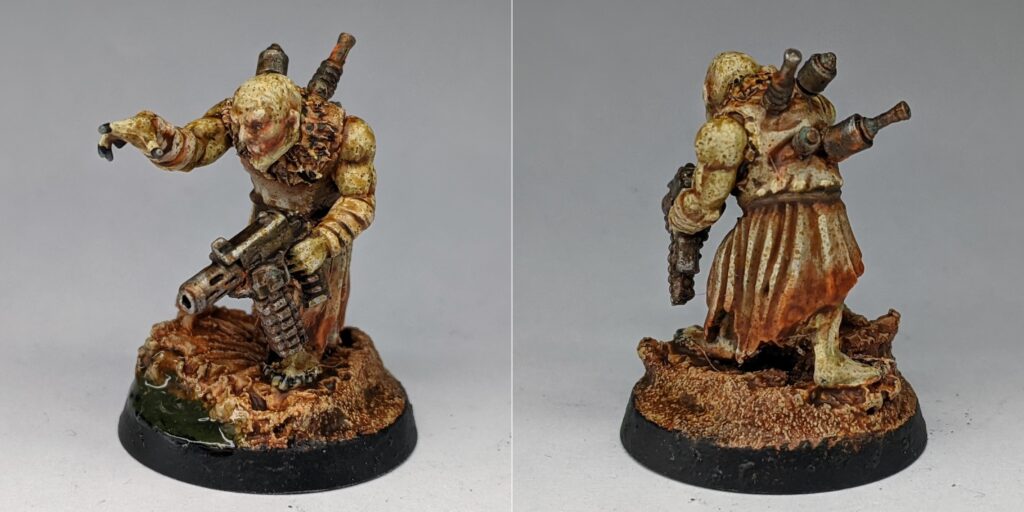
Cornyx ‘the Pathfinder’ is a sanctioned Imperial mutant, thanks largely to his useful skillset as a tracker in even the most hostile of environments. Inquisitor Sebastian Von Dernbach had first contracted the services of Cornyx as a guide through the great swamp beneath the underhives of Necromunda, noting his ability to retain a sense of direction regardless of any sensory or psychic interference. When it became clear that the reason for his prodigal sense of direction and clarity of mind was because Corynx was in fact a psychic blank, the Inquisitor offered Cornyx a place on his retinue.
As both a sanctioned mutant and Untouchable, Cornyx is not especially liked by his fellow crew member, with a tendency to isolate himself between deployments. He has been observed to have an unusual rapport with the Jokaero Pygmaeus, leading several others to claim that the mutant can communicate or converse with the Xenos engineer. This is, of course pure conjecture and such rumours are not to be believed or repeated by any informed agent of the Inquisition.
My Skavvie Tracker was the last miniature I kitbashed out of my own bits box, but the next day I started to think about what my retinue might still be missing. The first thing that popped into my mind was a Medicae character. For a time, I kind of considered just picking up Doctor Arachnos from Forgeworld, but something else that bothered me was the absense of female characters3. I decided to kill two birds with one stone here, and thought about how I’d make myself a female Medicae. I went with the body from a female Delaque ganger, arms from the female Rogue Doc sculpt for Necromunda, a backpack from the Gang Look-out included in that kit and a Skitarii head. These parts all came together with surprising ease and minimal green stuff work – pretty much a little Roll Maker cabling to attach the tubing on the backpack to the tubing attached to her rebreather collar and that was that. Everything about this conversion seemed to go together effortlessly – the arms and head both worked well with the pose and the Skitarii hood and respirator fitted seamlessly with the power plant and Delaque robes. With a predominantly white colour scheme, I think she comes off fairly well as a Medicae without having to resort to any freehand iconography.
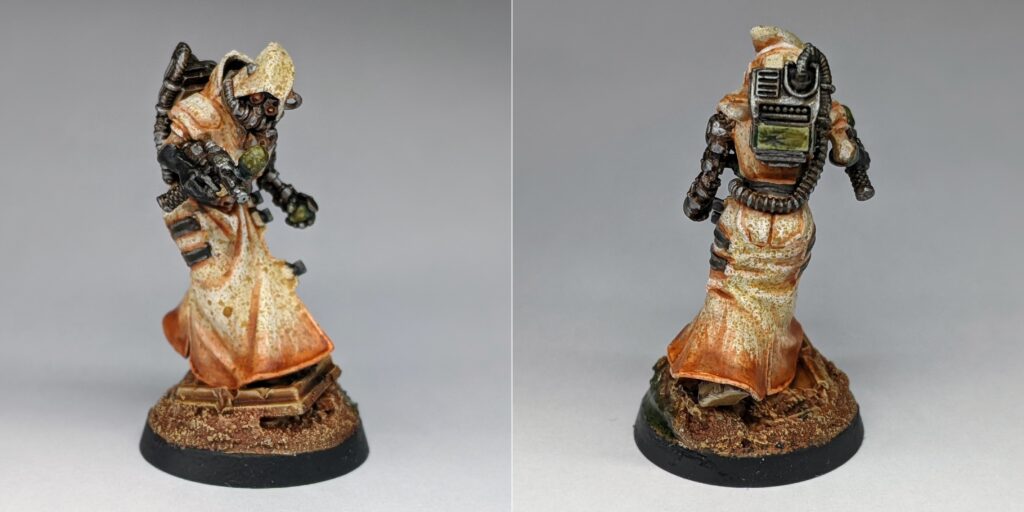
A daughter of Mars, skilled medical practitioner and passioniate bioengineer; Carmina Forschner has served in many roles over the course of her professional relationship with Inquisition Sebastian von Dernbach. Although relatively unaugmented herself (by the standards of the Cult Mechanicus), Forschner served the first 20 years of her career on Mars overseeing development of prosthetics and other augmentations for a high ranking Imperial officials.
It was in this capacity that the Inquisitor first encountered Forschner – during a requisition to develop a working implant, prosthesis or exoskeleton that could return the use of Von Dernbach’s legs. Several Imperial engineers, scientists and members of the Cult Mechanicus had attempted repairs, but every implant, exoskeleton or prosthesis failed to take due to ++REDACTED++. When Forschner herself was unable to restore the use of the Inquisitors legs, she designed the Ebon Throne – a mobility device consisting of a mechanical wheelchair, powered by a pair of Servo Skulls which serve as both a motor and a pair of counterweights to maintain perfect balance. This was intended as a temporary solution, and agreed to join his Inquisitorial Retinue such that she could continue to work on a permanent solution to the Inquisitor’s paralysed legs.
In her time as a member of this retinue, Carmina Forschner was made several strides forward to restore use of the Inquisitors legs – even allowing him to walk freely for short periods of time – while simultaneously saving the lives of several other members of the retinue in her makeshift duties as the ship’s medicae.
Alright, so that’s one female support character – but what about a combatant? For that, I decided to pick up a classic Death Cult Assassin. These are fine miniatures, but I’m kind of over the sword(s) held aloft pose, and a unique character needs a unique head. To sort this, I went and picked up some bitz online – I went for an Escher ganger head with a respirator, braided ponytail and mohawk, and a couple Witch Elf bitz to replace the arms and swords. Dark Elf ceremonial blades might not be the most Imperial looking weapons, but I felt they had a sort of vicious death cult vibe to them. I snipped the arms and head off carefully and did my best to reposition them, exchanging the hands for those from the Witch Elf bitz.
While one of the blades worked nicely, I couldn’t for the life of me get the second to look right. Necessity is the mother of invention however, so I decided to replace that entire arm with a flail arm from the Arco Flagellants kit. This was a happy little accident, and resulted in an altogether more dynamic, unique and ultimately more Blanchitsu looking miniature. Once again, I found the backstory practically wrote itself – the duality of the not-so-Imperial looking blade and the flail implant typically associated with Arco-Flagellation hinting at a tale of Heresy and Redemption.
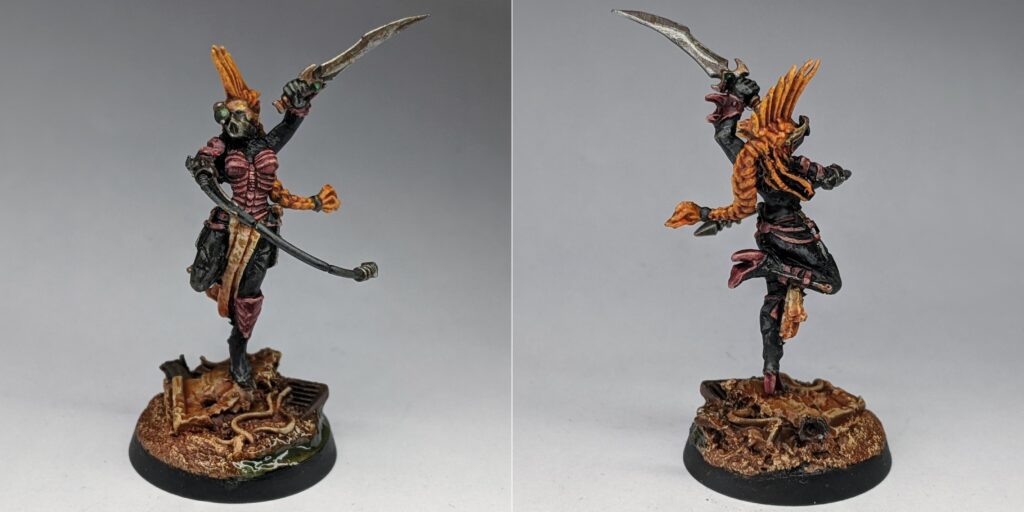
Latoria Civatte was first discovered by Inquisitor Sebastian Von Dernbach during an investigation into the dealings of Death Cult Mortem Aeternam. Such cults are known for taking in young orphans such as Civatte, who are fed and educated in exchange for their undying devotion and service to the God Emperor. As part of their duties, these orphans were to be sent out on contract assassinations, under the impression that they were killing traitors and heretics in His name – and to bring credits in to pay for their food and lodgings in the process.
The cult was brought to the attention of Von Dernbach after accusations of their involvement with the assassinations of several ‘squeaky clean’ governmental officials. Upon investigation, the Inquisitor unearthed that the inner sanctum of the cult had been corrupted by the taint of Chaos, and had been leveraging their resources to sow the seeds of war in an effort to appease the Blood God Khorne. The offenders were executed and the cult discredited and disbanded by order of the Inquisition.
Indebted to Von Dernbach and directionless following the death of her heretical former masters, Latoria Civatte pledged her services to the Inquisitor, where she has served as a dedicated and fierce acolyte and crew member of the Embers of the Emperor.
And finally we have a Jokaero Weaponsmith. Look, there’s nothing particularly special about this miniature other than the paint job, which is a maybe little more desaturated than you usually see with these minis. I mainly added this little guy to the retinue because a friend of mine joked to me that, were I to make an Inquisitorial retinue, I must have at least one Jokaero and, well, I kind of agreed. How often does one get the opportunity to paint a little token of 40Ks bizarre and diverse history like this?
The first time I set this miniature down next to my Skavvie Tracker, it was immediately noticeable how the pair are kind of posed the same, but mirrored. I thought this was a neat little coincidence, but the same friend from earlier suggested that the two should be close, or connected in some way. So one last time, the miniatures themselves helped inform the fluff behind the two characters.
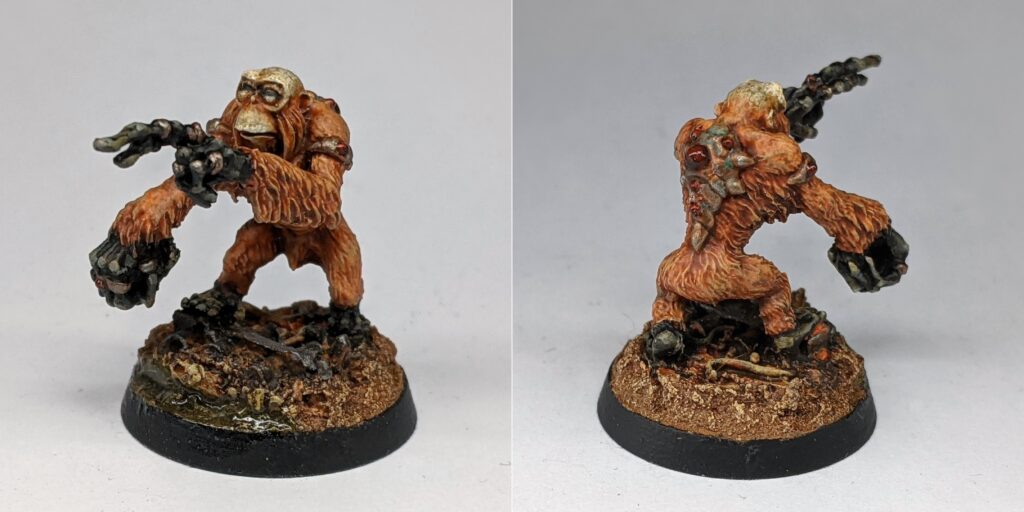
The spoils of a high stakes game of cards with the Rogue Trader Albus Mendax, the Jokaero Pygmaeus joined the Inquisitors crew in the role of engineer of sorts.
Despite an inability to communicate, the Jokaero has seen the Embers of the Emperor soldier on through several dangerous journeys through both the Warp and Lucky Space thanks to an intuitive understanding of the ships workings. With simple nutritional needs and an impressive ability to perform miracles from scrap, his value as an engineer more than compensates for his erratic output and inability to take orders.
It has been noted that the Jokaero has taken an unusual liking to the Sanctioned Mutant and Untouchable Cornyx, with whom he shares an unusual familiarity and companionship.
Phew, okay, that’s the last of them! Between the fluff in the captions and the conversion commentary, this has been a bit of a mammoth read – and I’ve barely even said a word about the paint jobs. Thankfully, there’s very little to say about these paint jobs that I haven’t already discussed at length, so check out my posts about my Eshin Skaven, Azog’s Legion and Adepta Sororitas if you’re interested in my approach to painting in a Blanchitsu style.
This was a really fun project to work on – it’s something that just sort of came out of nowhere and escalated very quickly from a single miniature all the way up to a whole new warband. I’m definitely going to return to this style of converting and painting miniatures in the future; it’s always gratifying to engage with the seedy underbelly of the Imperium of man, and very rewarding to do something that feels truly creative at every stage of the process.
In the short term, however, it’s looking like I’m set to return to the world of Malifaux next. Lockdown conditions have eased up a little in the United Kingdom, and I’m starting to get in the occasional game again. I’m slowly figuring out through experience what my crew is missing and what I need to add to it – so stay tuned for another exciting instalment of Makin’ Bacon soon.
In the meantime, thanks for reading and happy wargaming!
1 Alright, so parts 4 and 5 might’ve been interrupted by some other content but it’s still the longest ‘series’ of posts I’ve written on the same project.
2 I should really invest in some Necromunda kits. And some Skitarii, some Empire Greatswords, Sicaran Ruststalkers, a Cadian Command kit.. The list of great conversion fodder goes on and ever on.
3 At this point the only female character was the Daemonhost Prisoner 82 – and while the prisoner/host is a clearly female body, but the Daemon inhabiting the body is a maybe a little less clear cut.
